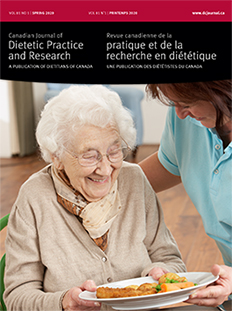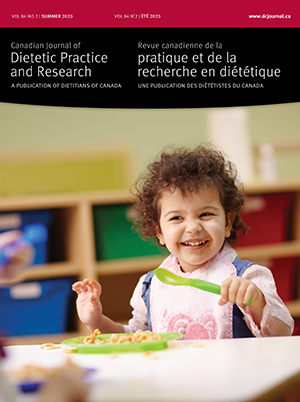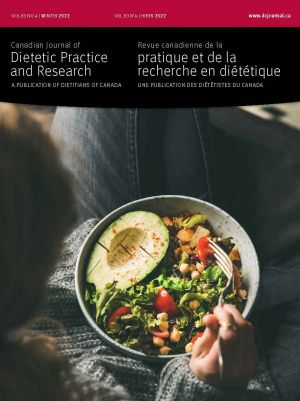Volume 81 • Number 1 • March 2020
Editor’s Message
Research
Purpose: To understand the perception of dietitians regarding the effects of multidisciplinary settings and Electronic Health Records (EHRs) on their dietetic practice for weight management.Methods: Individual semi-structured interviews were conducted with 14 dietitians working in multidisciplinary settings in Ontario. All interviews were audio recorded and transcribed verbatim. Two researchers coded the data independently using a thematic analysis approach. All themes emerged inductively and were refined iteratively.Results: Most dietitians believed that working in a multidisciplinary setting allowed for interprofessional collaboration and time-effective referrals. Multidisciplinary clinics were perceived to improve patient care due to convenient scheduling, consistent messaging, and ongoing support. However, some dietitians reported instances of conflicting approaches and beliefs regarding weight management across health professionals. Dietitians suggested ways to address these conflicting approaches through clinical meetings and education. EHRs were perceived to allow for collaboration through facilitated communication and knowledge exchange; however, lack of interoperability between EHR platforms across different types of health care settings was perceived to be a barrier for optimal care.Conclusions: Overall, multidisciplinary settings were perceived to positively impact dietitians’ practices for weight management as they allow for interprofessional collaboration. Consistency in health messaging across health professionals should be emphasized through knowledge exchange.
Purpose: To determine regular-texture menu variety offered in Canadian long-term care (LTC) homes and its association with residents’ food intake.Methods: Twenty-nine LTC menus from Alberta, Manitoba, New Brunswick, and Ontario were analyzed. Items offered during the regular-texture menu cycle were categorized according to Eating Well with Canada’s Food Guide food groups and variety scores were calculated per day and per week. Residents’ food intake was assessed by weighing and observing intake over 3 nonconsecutive days. Diet quality was determined using a mean adequacy ratio score (MAR) for regular and soft and bite-sized consumers (n = 394).Results: Average daily and weekly menu variety scores were 24 ± 5.8 and 78 ± 17.2, respectively, with significantly higher scores in Ontario (29 ± 2.7 and 102 ± 11.7). Of all the food groups, only the variety score for the “Other” food category was positively associated with protein intake. No associations were observed between variety and energy intake or MAR score.Conclusion: This study is the first in Canada to assess LTC menu variety. Although there was variability between provinces in menu variety, this was not associated with resident diet quality or intake.
Purpose: The vegetable/fruit intakes of a sample of children attending regulated childcare in Nova Scotia was assessed and compared by age groups (3 and 4–5 year olds) and by home and childcare environments.Methods: Seventy-nine children had 3–4-day food records and 58 had records from both environments. The data were coded by the 2007 Canada’s Food Guide (CFG) recommendations and the 2014 Classification of Foods in the Canadian Nutrient File according to CFG (CNF/CFG) Tiers. Descriptive statistics and tests of significance were determined.Results: Overall, 56% of children met the CFG vegetable/fruit recommendations but the percentage of older children meeting recommendations was half that of the younger age group; a significant difference. Fruit and juice comprised 65% of vegetable/fruit intakes with more consumed at home. Vegetable/fruit items were mostly from the higher quality CNF/CFG Tiers but more of the lower quality items were consumed at home.Conclusions: The 4–5 year olds may not be increasing their vegetable/fruit intakes as the CFG recommends. While just over half of children met CFG vegetable/fruit recommendations, the vegetable/fruit items were mostly high quality; fruit and juice predominated. Identification of strategies to support increased vegetable/fruit intakes of children in both home and childcare environments is warranted.
Purpose: To explore the associations between family meal context and overall diet quality of Canadian preschool-aged children.Methods: Cross-sectional analysis of 95 preschool-aged children from 72 families. Measures about health behaviours and the family meal environment were drawn from selected questionnaire items. Three-day food records for children were assessed using the Healthy Eating Index 2010 (HEI-2010). Linear regression was used to explore the associations between the family meal variables and children’s HEI-2010 scores.Results: In analyses adjusted for child age, sex, and household income, child involvement in meal preparation (β = 4.34; 95% CI: 0.56–8.12) and time spent preparing the evening meal (β = 3.77; 95% CI: 0.42–7.12) were associated with higher HEI-2010 scores. Serving fast food (β = −2.90; 95% CI: −4.79 to −1.02) and using screen-based devices during meals (β = −3.80; 95% CI: −7.38 to −0.21) were associated with lower HEI-2010 scores. Family meal frequency and serving prepared foods, sugar-sweetened beverages, and vegetables at meals were not significantly associated with preschoolers’ diet quality.Conclusions: The context in which family meals take place influences child diet quality. Taking the time to include children in family meal preparation may benefit children’s dietary intake.
Purpose: The purpose of this study was to explore the impact of dietary factors and biomarkers on lung function among Canadian adults (18–79 years).Methods: Our data source was the Canadian Health Measures Survey Cycle-3, which included 3397 adults. The household and clinic questionnaires and physical measures were used to assess individual dietary factors, modified Mediterranean Diet Scores, and biomarkers.Results: The overall mean percent predicted values for FVC and FEV1 were 97% and 95%, respectively. While somewhat inconsistent between outcomes, higher lung function was associated with bean, grain, milk, fruit, and vegetable consumption, whereas lower lung function was associated with egg and potato consumption. Among the biomarkers, vitamin D, chloride, total serum protein, and red blood cell folate were associated with higher lung function, whereas C-reactive protein and vitamin B12 was associated with lower lung function.Conclusion: Our study provides support for an association between some dietary factors and lung function, though not entirely consistent between a specific dietary factor and the outcomes studied (FVC, FEV1, FVC/FEV1, and FEF25%–75%). The associations between a specific biomarker and lung function were more consistent (i.e., observed with a larger number of lung function outcomes) than were the dietary factors.
Purpose: To examine the relationship between Food and Nutrition graduates’ involvement in faculty-supervised extracurricular experiential learning activities (FEEs) and the development of dietetic competencies.Methods: An original web-based survey, assessing involvement in FEEs and self-perceived level of Canadian dietetic competencies, was administered to Brescia University College Food and Nutrition graduates for graduation years 2011–2017. Competency scores were calculated for each respondent in 4 practice areas (Professional Practice, Communication and Collaboration, Population and Public Health, and Management), and summed for a Total Competency Score. Multiple linear regressions were used to assess predictors of competency scores.Results: The final sample consisted of 233 respondents who participated in 1.9 ± 1.1 FEEs. The highest average competency score (out of 100) was Communication and Collaboration (59.7 ± 31.7); the lowest was Management (40.3 ± 30.9). Total hours spent and breadth of experiences in FEEs were significant predictors of all scores (P < 0.05). Depth of experiences was a significant predictor of all competency scores (P < 0.05) except for Management (P = 0.27).Conclusions: Participation in FEEs contributes to Food and Nutrition students’ development of entry-level dietetic competencies; therefore, counting some FEEs as curricular credits may be warranted. Given the prominence of competency-based learning assessments, these results also have implications for faculty resources, budgets, and collective agreements.
Perspectives in Practice
Les simulations interprofessionnelles sont une approche pédagogique émergente de plus en plus utilisée dans la formation des professionnels de la santé. Bien que les avantages des simulations soient documentés exhaustivement dans le domaine de la médecine et des sciences infirmières, peu d’études ont exploré le potentiel de cette approche dans la formation des futurs diététistes. Cet article décrit quatre simulations, dont deux interprofessionnelles, axées sur la gestion des soins de la dysphagie qui ont été réalisées dans le cadre d’un programme de baccalauréat spécialisé en sciences de la nutrition et discute les mérites potentiels de cette approche pédagogique dans la formation des futurs diététistes.
This study aimed to determine dietitians’ familiarity with knowledge translation (KT), confidence in undertaking KT, and preferences for receiving KT training. An online questionnaire was designed and disseminated to all dietitians working across hospital and health services in Queensland, Australia, for completion over a 6-week period (April–May 2018). Of the 124 respondents, 69% (n = 85) reported being familiar with KT, but only 28% (n = 35) reported being confident in applying KT to their practice. Higher confidence was reported with problem identification, evidence appraisal, and adapting evidence to local context, compared with implementation, evaluation, and dissemination. Almost all respondents reported an interest in learning more about KT (n = 121, 98%), with a preference for easily accessible and short “snippets” of training aimed at beginner–intermediate level. Lack of management support, difficulty attending multi-day courses, cost, travel requirements, and lack of quarantined time were reported barriers to attending KT training. There is a high awareness and interest but low confidence in undertaking KT amongst dietitians. This highlights an opportunity for workforce development to prepare dietitians to be skilled and confident in KT. Training and support needs to be low-cost and multi-modal to meet diverse needs.










